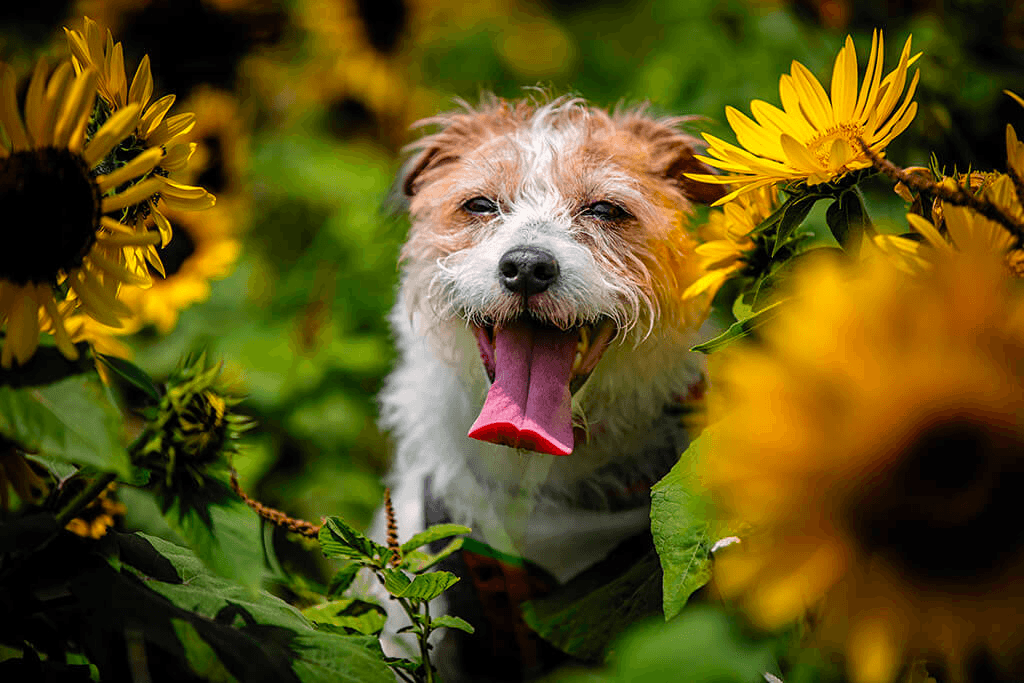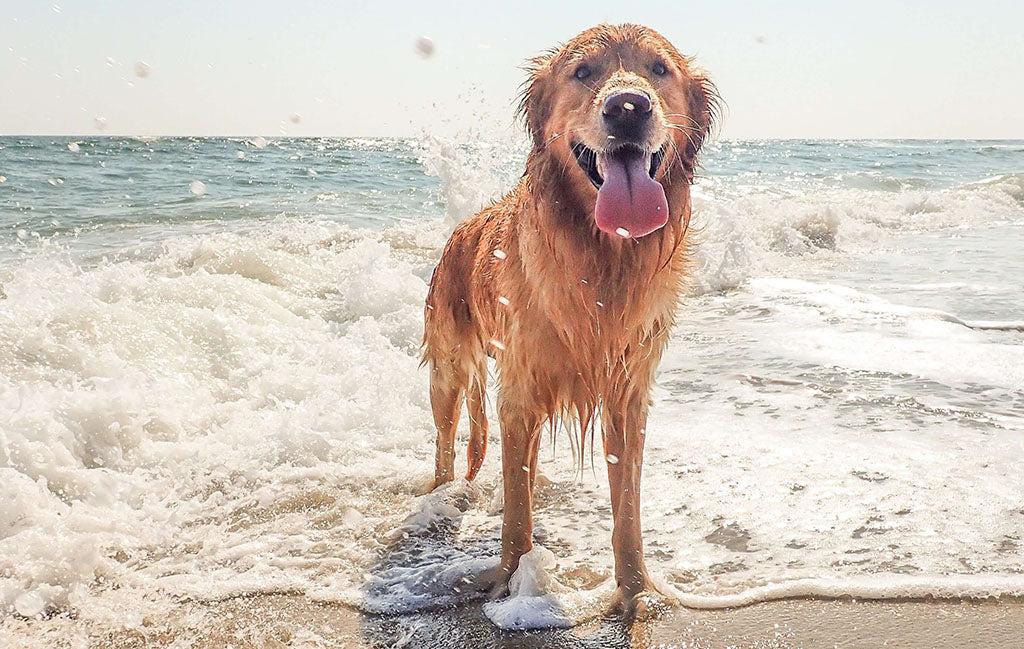If you want your dog to have a pearly white smile, practicing at-home dental care is essential. Follow these steps to keep your pup’s teeth sparkling.
- Home/
- Dog/
- Health & Wellness/
- How to Whiten Dog Teeth: 9 At-Home Steps to Take
How to Whiten Dog Teeth: 9 At-Home Steps to Take

A bright, healthy smile isn’t just important for humans—our canine companions benefit greatly from good dental hygiene as well. Healthy teeth are critical for a dog’s overall well-being.
Clean, white teeth not only improve your dog’s appearance but also support against dental issues. Unhealthy oral hygiene can impact a dog’s ability to chew, cause occasional discomfort, and affect their overall quality of life.
We talked to our vets about the best ways for pet parents to efficiently whiten dog teeth at home without causing discomfort or harm. Here are 9 practical steps to add to your dog’s at-home dental hygiene routine.
Are White Dog Teeth Healthy?
In general, white teeth are a great sign of good dental hygiene in dogs. Bright, clean doggy smiles usually show minimal tartar buildup, meaning the teeth and gums are being properly maintained.
That being said, without regular cleaning, dogs are prone to build up of germs and plaque, which can cause their teeth to yellow over time. Creating an at-home dental care routine can keep your pup’s teeth white and their mouths clean.
How to Whiten Dog Teeth: 9 At-Home Steps
Step 1: Brush Your Dog’s Teeth Regularly
Regular brushing is one of the most effective ways to maintain a dog’s dental health, says Dr. Sam Varon, veterinarian and owner of animal hospitals in Sacramento, California. “It prevents plaque buildup, which can harden into tartar and lead to tooth discoloration.”
Before you get to brushing, you want to have the right kind of brush and toothpaste for your dog. There are long-handled soft-bristle brushes for bigger dogs or finger toothbrushes for smaller breeds or dogs with sensitive gums.
And be sure to only use dog-safe toothpaste that’s non-toxic and formulated for pets. “Human toothpaste can be harmful due to ingredients like fluoride or xylitol,” Dr. Varon explains. Dog toothpaste contains enzymes that help break down plaque and neutralize bad odors, and it usually comes in flavors more appealing to your dog, like peanut butter or bacon.
Here’s the best way to brush your dog’s teeth:
- Introduce your dog to the toothbrush and toothpaste, giving them a reward and praise to establish a positive relationship with them. (i.e. Teeth brushing = Yummy treats!)
- Use your free hand to gently lift their lips to see their teeth and gums.
- Add a generous amount of toothpaste to the brush (similar to what you’d use for your own teeth) and gently brush back and forth with light pressure. The bristles shouldn’t flare out or flatten against your dog’s teeth.
- Take breaks as your pup needs them, especially if this is new to them. Give lots of praise throughout until all teeth are successfully brushed!
Step 2: Try Dog Dental Powder
Dental powders, like PetLab Co.’s ProBright Advanced daily dental powder for dogs, are a great hands-off way to clean your dog’s teeth. These powders are made with a special blend of ingredients that specifically target tartar buildup (even in those hard-to-reach spots) and bad-breath-causing compounds.
Simply add a scoop to your dog’s meal and the powder does the work for you without the stress and struggle of toothbrushing. Dental powders are a great teeth-whitening option for anxious or overly active dogs.
Step 3: Use Dental Wipes
Dental wipes are a convenient alternative to brushing, especially for dogs that aren’t fond of toothbrushes. You simply take the wipe and rub it over your dog’s teeth and gums to remove build-up and freshen their breath.
“[Dental wipes] are infused with ingredients designed to reduce tartar build up and may include mild abrasives for whitening,” Dr. Varon says. He says that, while not as effectient as brushing, dental wipes can still contribute to whiter teeth and better breath, especially when used regularly.
Step 4: Provide Dental Chews and Toys
Certain dental chews, like PetLab Co.’s Dental Sticks, are designed to promote dental health by targeting plaque and tartar as dogs chew. This chewing action and reduction in tartar buildup can keep teeth white.
Dr. Varon also explains that dog dental toys with ridges or nubs can also help stimulate the gums and clean between teeth.
Step 5: Incorporate Dental Treats into Their Diet
Dental treats are a tasty and easy way to promote your dog’s oral hygiene and whiten their teeth. These treats help reduce tartar buildup, leading to fresher breath and healthier gums.
According to studies, dental treats made with vitamin C and zinc sulfide have been beneficial against oral bugs. Owners can give their pup a treat 2–3 times per week, though it’s important that the treats are the right size for your dog’s breed and weight.
Step 6: Apply Dental Gels and Sprays
Dog dental gels and sprays are easy-to-use products designed to whiten teeth and freshen your dog’s mouth. While some at-home products may claim you won’t need to brush your dog’s teeth when using them, it’s best to pair the two together for a full effect.
Look for dental sprays or gels made with chlorhexidine. This ingredient helps decrease bacteria and slows plaque formation. It’s commonly used at veterinary clinic’s when doing professional cleanings as an after-rinse but can also be found in some at-home products.
Step 7: Feed a Dental-Friendly Diet
There are specific dental diets formulated to reduce plaque and tartar in dogs. “These diets often have kibble designed to break apart in ways that clean teeth as the dog chews,” Dr. Varon says. The shape is often different from normal dry dog food to allow this unique cleaning action, and it requires more chewing which leads to more saliva, helping remove residue.
Dr. Varon explains that some dental diets contain ingredients that bind calcium to reduce tartar formation, as well. Working with your vet can help in selecting the right dental diet for your pup.
Step 8: Regular Use of Dental Formulas
Dental formulas are liquid supplements you add to your dog’s water bowl to break down tartar and fight bad breath. Products like Petlab Co.’s Dental Formula offer a tasteless and hassle-free way to maintain good oral hygiene.
Simply add a teaspoon of the formula to 8 ounces of water and let your pup drink it up. It can even hit those hard-to-reach spots you might not get with a toothbrush.
Step 9: Conduct Regular Mouth Inspections
Checking your dog’s mouth regularly is crucial for maintaining good hygiene and catching any dental issues early on. Gently lift your dog’s lips and look at their teeth and gums. Watch for signs like bad breath (worse than just typical doggy breath), discolored teeth, gum problems, or loose or broken teeth.
If you see anything concerning, have your dog seen by their vet for a dental checkup. It may be time for a professional cleaning or your vet may be able to give you advice on your at-home routine.
Natural Ways to Whiten Dog Teeth
Dr. Varon explains that, while vet-approved dental products are the way to go, there are some natural ways for dog parents to help whiten their pup’s teeth at home:
- Coconut oil: Coconut oil has natural antibacterial properties that may help reduce plaque and promote overall oral hygiene. Some dog owners apply it to a dog’s teeth or add small amounts to their food. Dr. Varon says that, while it may not significantly whiten teeth, it can support oral health.
- Crunchy vegetables: Feeding dogs crunchy vegetables like carrots or celery can help keep teeth clean, but this shouldn’t be a replacement for regular brushing.
- Green tea extract: Adding a small amount of green tea extract to your dog’s kibble has been shown to reduce bacteria and plaque in dogs by nearly 60%.
Use Caution With Other Natural Whitening Remedies
Some pet parents use baking soda or apple cider vinegar in small amounts to whiten teeth, but Dr. Varon cautions us on this. These substances can be abrasive or acidic, potentially causing more harm than good.
When to Consult a Veterinarian
If your dog has persistent bad breath, discolored teeth (yellow, brown or gray), gum issues, or visible buildup on their teeth, it’s a good idea to have them seen by your veterinarian for a dental check. Depending on the severity of the buildup, your vet may recommend a professional dog dental cleaning.
“Professional cleanings are essential for maintaining a dog’s long-term dental health, particularly when home care isn’t enough to prevent buildup,” Dr. Varon says. Professional dental cleaning typically involves:
- A pre-cleaning physical examination
- A thorough oral exam to check for any underlying issues like tooth decay or gum disease
- Dental X-rays to evaluate the tooth roots, looking for any damage or sign of infection
- General anesthesia to ensure your dog remains still and comfortable
- Scaling (deep cleaning) to remove plaque and tartar from teeth and under the gumline
- Polishing to smooth the surface of the teeth, which makes it harder for plaque to accumulate
Dr. Varon notes that, if your dog is showing any more serious signs of dental issues, it’s vital to have them checked out ASAP. These could include:
- Sensitive gums
- Difficulty eating or reluctance to chew
- Drooling or pawing at the mouth
- Loose or missing teeth
Conclusion
At-home dental care is essential for maintaining your dog’s overall health and well-being. By using a combination of regular brushing, dental treats, gels, and mouth inspections, dog parents can help whiten their dog’s teeth by preventing buildup, along with freshening their breath and avoiding costly vet visits. These simple steps will not only lead to a brighter doggy smile, but a healthier, happier dog overall!
 E
E



